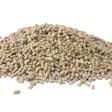
Soybean meal produced in the U.S. could boost feed efficiency and egg production for layer operations, with recent research revealing higher amino acid digestibility and metabolizable energy compared to alternative ingredients from other regions.
"The quality of soybean meal made from the U.S. is consistently higher in digestibility of essential amino acids and in metabolizable energy," Thomas D'Alfonso, director of animal nutrition at the U.S. Soybean Export Council (USSEC) said. "That right there comes from the sustainable farming practices of the U.S. soy farmer."
The quality advantage of soy produced in the U.S. also stems from natural field drying that prevents nutritional damage common in mechanically dried beans.
Technologies used by soy producers are “cost-effective” and “good business practices,” but also make "the crop very uniform from one place to another in the field and from season to season," explained D'Alfonso. "Having uniform feed helps layers because it helps them perform more consistently."
An additional benefit for layer operations using U.S. soybean meal is that they can differentiate their products by labeling eggs as fed with sustainable U.S. soy and calculating carbon footprint reductions — advantages that resonate with increasingly informed consumers interested in production practices and animal nutrition.
Feed consistency drives layer profitability
The egg industry maximizes revenue by producing grade A large eggs, which command higher prices than other sizes. Feed and ingredient consistency helps layers perform uniformly, resulting in more eggs at target weights and sizes, as well as stronger eggshells.
"If layers receive a diet that's highly variable in nutrient composition, particularly in essential nutrients like calories or calcium or an essential amino acid, then they'll compensate by consuming more feed," D’Alfonso explained.
"The net effect of high variability is increases in feed consumption, which decreases feed efficiency."
Layer producers should maintain minimum 25% soybean meal inclusion rates to establish a consistent nutritional foundation. This approach reduces overall diet variability while providing functional compounds including saponins, isoflavones and bioactive peptides, he recommended, he added.


















